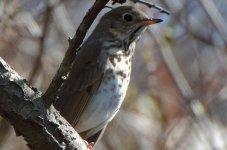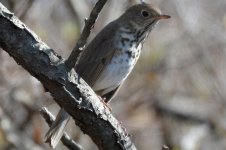NJ Birders
Well-known member
Hello all,
Wondering if it's possible to ID this one from the photos. These were taken 4/12/14 in NJ, USA. Bicknell's? Gray-cheeked? I read in the Stokes guide that for a Bicknell's - the yellow part of the lower mandible tends to be 1/2 or more the length of the bill and yellow to yellow-orange. The yellow portion on the Gray-cheeked tends to be 1/2 or less the length of the bill and a duller yellow. How reliable is that as a field marker? Of course, I did not hear the bird vocalize. Thanks in advance for any input.
Wondering if it's possible to ID this one from the photos. These were taken 4/12/14 in NJ, USA. Bicknell's? Gray-cheeked? I read in the Stokes guide that for a Bicknell's - the yellow part of the lower mandible tends to be 1/2 or more the length of the bill and yellow to yellow-orange. The yellow portion on the Gray-cheeked tends to be 1/2 or less the length of the bill and a duller yellow. How reliable is that as a field marker? Of course, I did not hear the bird vocalize. Thanks in advance for any input.






